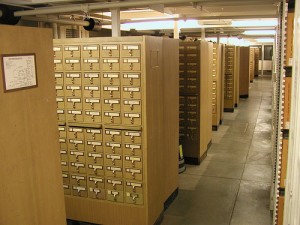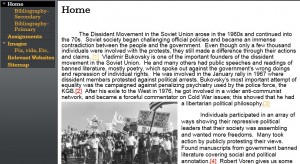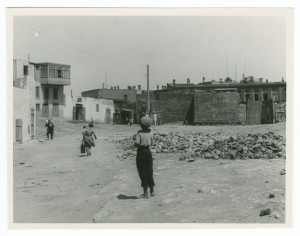
“Gulag Studies” has progressed enough, at this point, that it is possible to teach a
seminar course on the Gulag. Steve’s excellent posts on images and primary sources show some of the amazing resources out there. In terms of historiography, we now have a developed (or developing) literature on memoir analysis, oral history, forced labor and economics, official camp culture, resistance, release, women in the camps, sexuality, local studies, special settlements, the post-Stalin era, and life for prisoners after the camps, and more. There is even an annual, peer-reviewed journal titled Gulag Studies, published by the small publishing firm of Charles Schlacks Jr. Indeed, the problem for the instructor, at this point, is not one of finding and locating enough material for a course, but making difficult decisions about what to exclude. In this post, I’d like to suggest possible topics and (taking up Steve’s challenge) secondary sources for a Gulag seminar course.
Steve has already pointed to two of the best on-line resources for students and instructors, his own http://gulaghistory.org and the excellent “Mapping the Gulag” (http://gulagmaps.org). There are other amazing English-language electronic resources, too, including the sound archive, “European Memories of the Gulag” (http://museum.gulagmemories.eu – in multiple languages).
The Gulag as a seminar topic lends itself well to the use of Web 2.0 technologies in the classroom. The use of wikis and blogs can be an especially powerful way to reach students, who are comfortable with the on-line format and with expressing opinions “electronically.” If public, moreover, blogs are a way to break down the ivory tower. My 2011 course blog, “Communism and the Environment,” for example, had over 1200 unique visitors during the semester, from all over the world. The blog has continued to generate hits, with over 3000 unique visitors since it went live. But even a private wiki or blog would work well for a Gulag course. Students would have the opportunity to discuss issues and problems before coming to class; the class would thus be an in-person extension of what is already an active discussion. Because the Gulag is a topic that deals with issues of trauma and intense suffering and a topic that raises theoretical questions pertaining to state power and the nature of totalitarianism, an on-line discussion forum—whether private or public—could be extremely beneficial.
Structurally, I believe that a thematic approach would work best. If one wishes to assign a general overview of the camps, the abridged version of Solzhenitsyn’s Gulag Archipelago could work. Applebaum’s Gulag: A History basically follows Solzhenitsyn’s general argument and structure, and is more accessible. We now also have Steve Barnes’ Death and Redemption, which offers a scholarly analysis and, crucially, integrates the history of the Gulag with the history of Soviet state building and the Soviet ideological project. Both Gulag: A History and Death and Redemption contain chapters dealing with many of the main thematic topics for a Gulag history course.
Below I’ve outlined a possible 14-week seminar course on the Gulag, with some suggested readings (by no means an exhaustive list). The suggested readings will mostly be familiar to specialists, but hopefully readers find my arrangement and suggestions helpful. The order of these topics could easily be shuffled around. For more sources, see the two-part bibliography that I compiled with Marc Elie: “Selected Bibliography of Historical Works on the Gulag,” Gulag Studies 1 (2008); and “A Supplement to the Selected Bibliography of Historical Works on the Gulag,” Gulag Studies 4 (2011).
Week One: Precedents
This week one could examine the fascinating work by Andrew Gentes and/or Abby Schrader on the Tsarist-era penal and exile systems. Gentes is particularly sensitive to some of the similarities and differences between the Tsarist and Soviet systems, and thus provides a nice balance to Solzhenitsyn, who dismisses any comparison.
Another option would be to examine the origins of the concentration camp as precedent for the Gulag. There are some fascinating avenues for exploration with the Spanish reconcentrado camps set up in Cuba; the British-run camps in South Africa during the Anglo-Boer War; and the German-run internment camps in South-West Africa during the war with the Herero. That all three of these early examples appeared in colonial contexts is not coincidental, and, for an advanced seminar course, it may be worth examining the extent to which the Gulag itself was part of a Soviet “colonization” process, as scholars such as Lynne Viola have begun to do.
Week Two: Understanding Soviet Criminal Justice
On the other hand, the Gulag was also the Soviet Union’s penal system, and thus some understanding of Soviet criminal justice is necessary for a full analysis of the camp system. Peter Solomon’s Soviet Criminal Justice Under Stalin remains the key monograph for this topic, but I also highly recommend work by Kragh (“Stalinist Labour Coercion During World War II”) and Kowalsky (Deviant Women).
One could focus on the Soviet police, and recent works by David Shearer (Policing Stalin’s Socialism) and/or Paul Hagenloh (Stalin’s Police) are quite useful. Shearer’s article in the Journal of Modern History, for example, raises a number of key questions about the growth of repression via the state’s desire to keep track of its citizens/subjects.
Week Three: Explanations
The historiography has developed to the point where there are now a variety of explanations for the Gulag. The main area of contention is whether or not the Gulag was primarily an economic institution of forced labor, or a political institution of repression. For a nice contrast that should raise considerable discussion, I highly recommend assigning the introduction to Paul Gregory’s The Economics of Forced Labor, the introduction to Barnes’ Death and Redemption, and the introduction to Applebaum’s Gulag: A History.
Week Four: The Peasant Archipelago
Stalinist repression of the peasants was key to the expansion of the Gulag camps and the “other archipelago” of the special settlements. Indeed, it is impossible to understand the Gulag through a focus solely on the intellectuals in the camps, incarcerated under Article 58 of the criminal code (counter-revolutionary crimes). The state’s antagonistic relationship to the peasants was a crucial factor for the Gulag’s growth. I recommend Scherer and Jakobson’s article, “The Collectivisation of Agriculture and the Soviet Prison Camp System,” as well as the many articles by Lynne Viola on the special settlements, or her excellent book, The Unknown Gulag, which adroitly places the history of the settlements within the history of the camp system. Nicholas Werth’s Cannibal Island, while not directly about peasant exile, is a fascinating narrative account of an exile settlement in Western Siberia that is highly readable for an undergraduate audience, and also provides considerable information about the inefficiencies of the Gulag and center-periphery relations.
Week Five: Gulag Official Culture
Perhaps surprisingly, each camp within the Gulag maintained a Cultural-Educational Department, nominally in charge of re-educating criminals into productive Soviet citizens. There is a growing body of literature on the subject of official culture in the camps, although mostly still in article format. Yet the topic of re-education is a thread that runs through Barnes’ book, and is also dealt with in some depth in Ruder’s Making History for Stalin. For article-length studies, see my own “One Day in the Life of Educator Khrushchev,” Barnes’ “‘All for the Front, All for Victory!’,” and Drasckozy’s (hyperlink is a .pdf) “The Put’ of Perekovka.”
Week Six: Unofficial Gulag Culture
The best resource for this topic remains the memoir literature. Steve made some good suggestions in his post. I’d also recommend Margarete Buber-Nuemann’s Under Two Dictators, as she has great descriptions of life in the camps and also provides fascinating points for comparison between the Gulag camps and the Nazi camp of Ravensbrück. Steve’s website, http://gulaghistory.org has excellent resources on this topic, too. Major research libraries may carry the Memorial Society’s Museum Catalogue, Art and Life in the Gulag. Some of this material is available on-line in English at http://www.memo.ru/museum/endex.htm.
Week Seven: The Gulag Memoir
I recommend at least one or two full weeks devoted to Gulag memoirs. Again, Steve has suggested some of the more accessible and interesting first-hand accounts. For a short but powerful memoir, I highly recommend Hava Volovich’s “My Past,” in the memoir collection, Till My Tale Is Told. Unlike most memoirists, Volovich was not in the camps under Article 58. Other memoir collections in translation include Remembering the Darkness and Gulag Voices: An Anthology. There is a growing body of scholarship that analyzes memoirs from the perspective of literary criticism, and Leona Toker’s pioneering work on this subject is an excellent choice.
Week Eight: The Gulag in Fiction
As Steve suggested, Solzhenitsyn’s One Day in the Life of Ivan Denisovich and Shalamov’s Kolyma Tales are both excellent, and raise many issues for discussion. Russian television has also made mini-series versions of Solzhenitsyn’s First Circle and Shalamov’s Kolyma Tales. I’m not sure when or if these will be available with English subtitles, but they are both high quality productions, and one can find clips on YouTube (here and here, for example). Although I have not yet watched the television version of Kolyma Tales, the version of First Circle is quite well done.
Week Nine: Oral History and the Gulag
Continuing with several weeks focused on the prisoner experience, Jehanne Gheith’s Gulag Voices: Oral Histories of Soviet Incarceration and Exile provides considerable material for class discussion, not only for what the ex-prisoners say, but how they say it, and what they leave out or do not discuss. Indeed, issues of memory and trauma can be discussed in some depth in relation to this text. Another possibility is Stephen Cohen’s oral history, The Victims Return.
Week Ten: Local Studies
Recent scholarship on specific camps is, I think, especially strong at pointing out the economic aspects of the Stalinist camp system. Articles on Norilsk in the aforementioned The Economics of Forced Labor, for example, show that central authorities could focus considerable resources and effort on camps that were viewed as high priorities, economically. Judith Pallot’s remarkable “Forced Labour for Forestry” examines the interaction between free and forced labor in Perm’ province. Alan Barenberg’s work on Vorkuta, Nick Baron’s on Karelia, David Nordlander’s on Kolyma, and others also provide students with an interesting picture of how the Gulag functioned in various locales.
Week Eleven: Women in the Camps
Cathy Frierson’s English adaptation and re-working of Simeon Vilensky’s Deti GULAGa (published in English as Children of the Gulag) contains information and primary material about issues specific to women and children in the camps. The memoir literature is, of course, rich with material from women memoirists. There are two anthologies specifically devoted to women’s experiences (Till My Tale Is Told and Remembering the Darkness, mentioned above), as well as Ginzburg’s key two-volume Journey Into the Whirlwind and Within the Whirlwind, and more. Golfo Alexopoulos’ work on release from the camps sheds light on how the administration viewed women prisoners.
It may soon be possible to conduct a separate class session on sexuality and gender in the camps, as Adi Kuntsman has begun to examine this topic.
Week Twelve: Camp Personnel
Unfortunately, we still have little scholarly analysis of camp personnel. Mochulsky’s memoir, Gulag Boss, provides considerable room for analysis, and could be excellent for undergraduates, as the book raises interesting questions about what Mochulsky chose to include and what he chose to omit. There is a lengthy section on the guards in Galina Ivanova’s Labor Camp Socialism, and Nordlander has published an article-length analysis of the Dalstroi bosses, but much more work remains to be done. Recent conference papers (link is a .pdf) related to the topic show that more studies are likely forthcoming.
Week Thirteen: Resistance
Resistance is one of the few topics that has garnered considerable scholarly attention, mostly focused on the strikes and rebellions of the post-Stalin period. During the Stalin era there were also strikes and other acts of resistance (including everyday forms of resistance such as foot-dragging, data falsification, and other informal practices), but these have received less attention. Steve’s article on the Kengir uprising is very well done, and one can also look to earlier work of Graziosi (“The Great Strikes of 1953”) or Craveri (in the book, Free and Unfree Labour).
Week Fourteen: The Gulag after Stalin
Finally, several scholars have focused on the issue of what happens to the Gulag and its prisoners after Stalin. Miriam Dobson’s Khrushchev’s Cold Summer is the place to start, but articles by Jeff Hardy in the Russian Review and Kritika also point to new developments in this field. Both Dobson and Hardy’s work highlight some of the ambivalence surrounding the camps and Khrushchev’s “thaw,” but with a different focus and a somewhat different take. Alan Barenberg’s forthcoming monograph on Vorkuta, which traces Vorkuta’s development from prison camp to mining town, sheds light on the transition between the Stalin and post-Stalin era camps. Nanci Adler continues to research the ways in which ex-prisoners adapted to life after the camps, and work by Kathleen Smith looks at the issue of the memory of the Gulag and the collapse of the Soviet system. Some of the electronic resources, such as http://gulagmaps.org, cover the entire post-Stalin period, too.









